A Study of Flavor Profiles
Understanding how to combine and balance flavors is an important cooking concept that will allow you to create flavorful dishes every time you cook.

When I was a kid, my job in the kitchen was to season and tenderize the meats that would go into our family’s stir-fries, stews, and curries. I would sprinkle pieces of chicken, pork, and beef with salt, white pepper, and sugar. Yes, you read that right, we always seasoned our meats with just a bit of sugar. My grandmother explained that the sugar wouldn’t make the meat taste sweet but rather create balance and enhance the effect of the salt.
Understanding how to combine and balance flavors is an incredibly important cooking concept, and it’s especially evident in Asian food.
I think this is why just about everyone enjoys Chinese, Thai, Vietnamese, or Japanese cooking (they’re definitely the most popular meals in our meal plan archives). Every dish is so dynamic in flavor. A Thai curry has sweetness from coconut milk and sugar, savoriness from fish sauce, spicy and earthy notes from herbs in the curry paste, and sour from the finish of lime juice. All these different flavors combine to achieve a delicious balance on our taste buds.
Luckily, you don’t need to go to culinary school to learn how to do this. We’re here to give you a graphical study of flavor profiles as part 3 of our ‘How to Maximize Flavor’ series.
First, let’s review the basic flavors. Up until 2002, scientists recognized 4 ‘official’ tastes: 1) salty; 2) sweet; 3) sour; and 4) bitter. However, in 2002 umami was crowned the fifth flavor. Umami simply means yummy in Japanese, and it’s hard to describe what the flavor of umami tastes like. For simplicity sake, we are lumping it with salty in this lesson because they share a lot of the same flavor attributes.
If you are offended by this, you probably should be attending culinary school because your taste buds are far more refined than ours are. For the purpose of this flavor lesson, we’re also including spice as our fifth flavor because we love a little heat.
By the end of this cooking lesson, you’ll understand how to balance and enhance flavors and also have a lot of new ideas for how to add any of these five flavors to your meals. Let’s go!
The Flavor Star
Because so many of us learn graphically, we created a Flavor Star to show you how these five flavors work to balance or enhance each other.
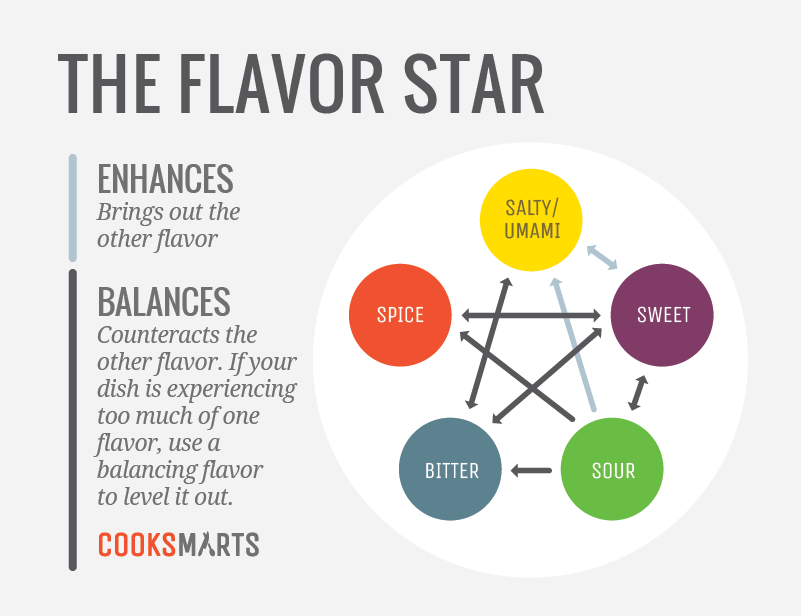
If a flavor balances another flavor, it means it counteracts or offsets that flavor to achieve an even more harmonious taste. For example, spice balances sweet and sweet balances spice. It’s why Mexican hot chocolate is finished with a pinch of cayenne pepper – the spice works with the sweet to produce a more dynamic flavor.
Or if you have a dish that’s too spicy, you can also balance the heat with something sweet. So if you ever over-spice a curry or sauce, just add a bit of your preferred sweetener (or use one of our ideas below in the sweet section), to neutralize the heat.
Flavors can also enhance each other. If you look at the Flavor Star, you see that salty enhances sweet and vice versa. This is why there are sea salt caramels or sea salt chocolate chip cookies. That light addition of saltiness actually amplifies the sweetness of those caramels and cookies.
If you keep this Flavor Star handy, you can learn how to create more dynamic flavors, rescue dishes that have been overly flavored, and also how to amplify certain flavors. Now let’s dig a bit deeper into each of our five flavors.
Salty and Umami / Savory
As mentioned before, we’re lumping salty and umami together because they share a lot of the same characteristics. If you ever end up with a bland dish, the likely issue is that it’s just under-seasoned (i.e., lacking salt or umami-ness).
Any Top Chef viewer knows that an under-seasoned dish is the most common mistake made by the show’s contestants, who are all professional chefs. Clearly under-seasoning is not just a rookie mistake, so don’t ever feel bad about a bland dish – just learn how to fix it with our tips!
Below we’ve come up with a bunch of different ideas on how you can fix an under-seasoned dish. Clearly salt is the obvious option but there are a lot of other condiments and ingredients that can add savory depth to your meal.
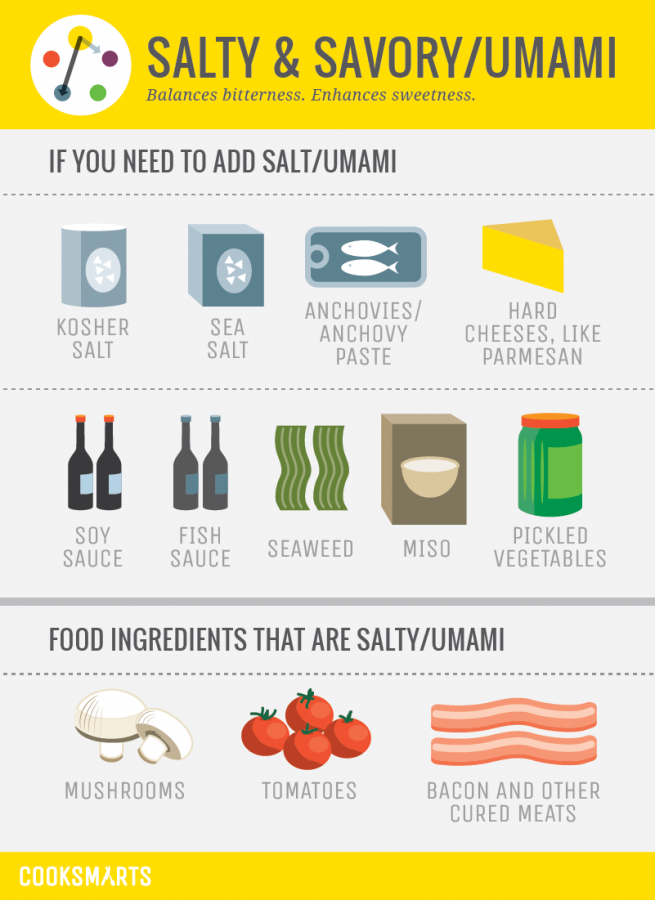
Some ideas:
- Add a splash of soy sauce, fish sauce, or miso to broth or stock
- Saute veggies with a little bit of anchovy paste
- Simmer soup with the rind of parmesan cheese
Some foods also naturally have an umami flavor. If you refer back to our Flavor Star, you’ll know to use something sweet or sour to further enhance this umami flavor.
Sweet
Sweetness is not just for desserts. According to our Flavor Star, sweetness balances sour, bitter, and spice, so if you have dishes or ingredients that have any of these flavor profiles, add a bit of sweetness to create something even more interesting.
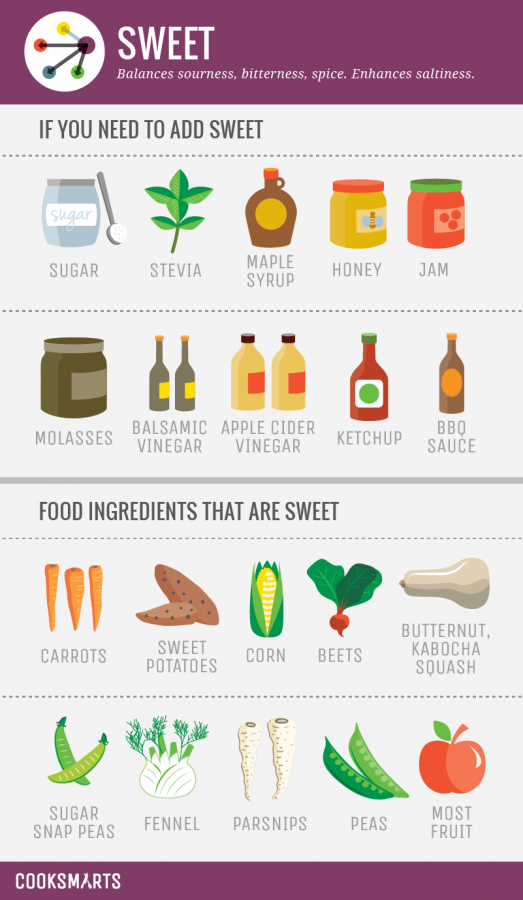
Some ideas:
- Add some honey, maple syrup, or jam to an acidic vinaigrette to neutralize the sourness of the vinegar
- Toss roasted brussels sprouts, which are bitter, with some sweet BBQ sauce
- Add some sugar to an overly-spiced curry or soup
For the ingredients that are naturally sweet, you can enhance their sweetness with something salty or umami flavored, like tossing roasted carrots and sweet potatoes with some miso paste.
Sour
Sour also balances spice and sweetness. This is why a dollop of yogurt is perfect for a spicy curry or stew. It helps to counteract that heat, creating a new balance of flavors. It’s also why sweet and sour chicken is such a popular Chinese dish. They combine to produce a delicious new taste.
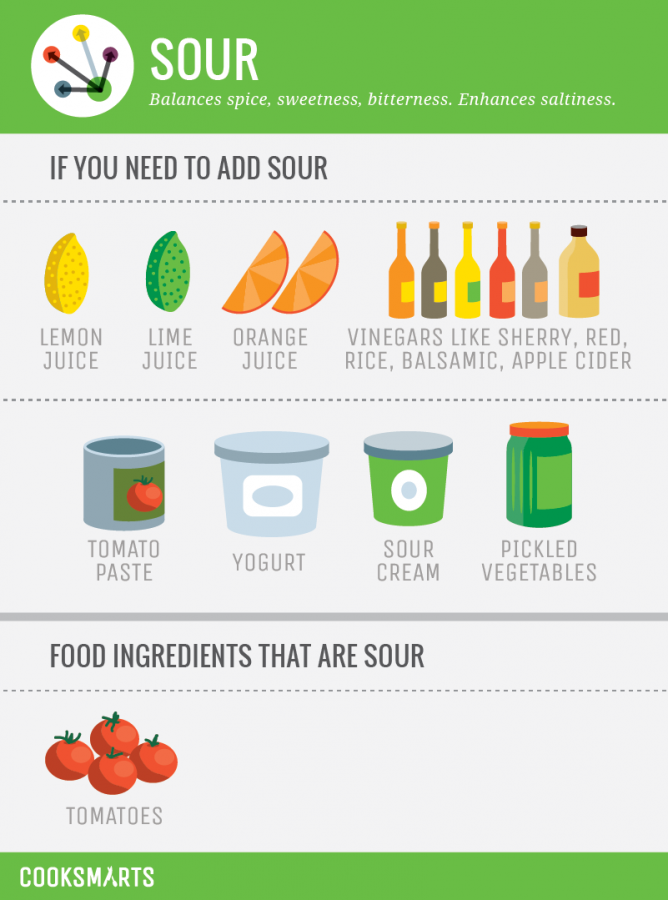
Bitter
Typically you don’t want to add bitter to your meals, but if you do, according to the Flavor Star, you should use it to balance out salty or sweet flavors. You can do that with some coffee, cacao, grapefruit juice, or even beer.
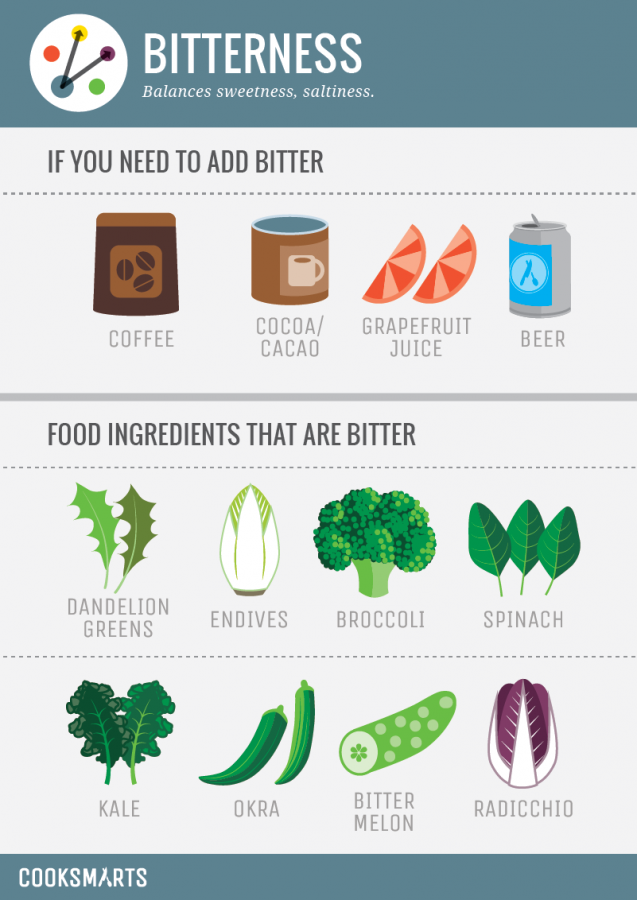
Even though you rarely add bitter to dishes, there are lots of ingredients that are naturally bitter, namely our green vegetables. To make it a bit easier to enjoy these bitter veggies, you can add some sweet, salty, or even sour.
Some ideas:
- For a perfect combo, use a vinaigrette that’s a bit sweet, salt, and sour to accompany a salad with endive, spinach, radicchio, or kale
- Help your kids gobble down their broccoli by roasting them with a bit of brown sugar and / or balsamic vinegar
- Dip okra into yogurt for a deliciously healthy treat
Spicy
Even though the Flavor Star spice balances sour and sweet, we’re going to go a bit off the diagram here. Honestly if you like a bit of spice in your food, just add spice. Below we’ve got a few ideas beyond hot sauce for how add a some kick to your meals.
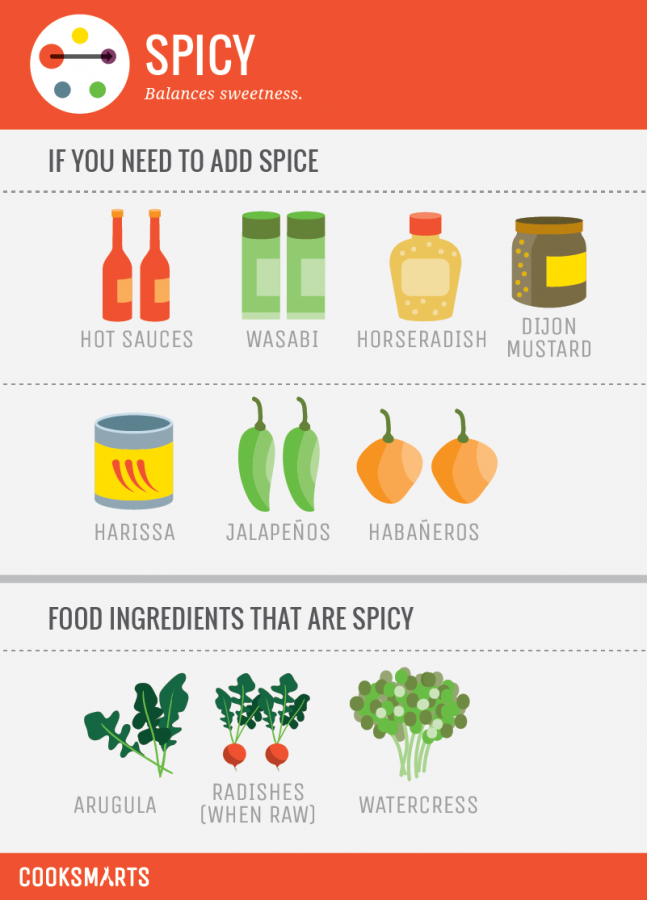
Our favorite hot sauce is Sriracha and Tapatio. What’s yours? Let us know in the comments below!
We hope this study of flavor profiles helps you create deliciously balanced meals and find new ways to add flavors to your cooking. As always, we work incredibly hard to create this cooking info, so please do help us spread the smarts by sharing on Twitter, Facebook, or Pinterest!
Also, you can get this infographic professionally printed to hang on your wall or fridge. Just head over to our Shop, where a portion of our merchandise profits are set aside to support food education.
If you’d like to print out the full infographic to hang on your kitchen wall or put in your cooking resources binder, you can download it for free here:

GET ALL THE INFO BELOW DELIVERED TO YOUR INBOX FOR FREE
Week 1: Our 3 Simplest Flavoring Secrets
Week 2: Spice Up Your Cooking with Our Spice Charts
Week 3: A Study of Flavor Profiles (that’s this week!)
Week 4: 5 Sauces You Can Use on Everything
Week 5: Keep it Fresh with Herbs
Week 6: Using Aromatics to Add Depth
Week 7: Surprise Giveaway!
